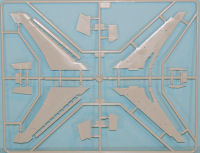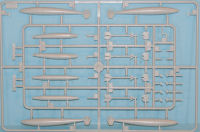
Trumpeter 1/72 F-100D Super Sabre Kit First Look
by Michael Benolkin
| Date of Review | May 2010 | Manufacturer | Trumpeter |
|---|---|---|---|
| Subject | F-100D Super Sabre | Scale | 1/72 |
| Kit Number | 1649 | Primary Media | Styrene |
| Pros | Updated scribed surface details, more detail around the airframe | Cons | Minor issues carried over from the 1/32 Trumpeter kit design |
| Skill Level | Basic | MSRP (USD) | $34.95 |
First Look
 |
 |
 |
 |
 |
 |
 |
The F-100A was a supersonic day fighter, a high-speed sports model of the F-86 Sabre dogfighter. While the F-100A did enter operational service, more aerodynamic problems were discovered including inertia coupling and low-speed wing-tip stalling which would lead to a sudden pitch-up of the aircraft. Despite its problems, the F-100A was kept on operational rolls for a number of years, but it was quickly displaced by the F-100C.
The F-100C had similar stability issues as the F-100A, but it also incorporated additional pylons, air refueling capabilities, and the ability to carry and deliver nuclear weapons. Like the F-100A, the F-100C did not have trailing edge flaps for take-off and landing - these were incorporated with the F-100D. These aircraft did have the aerodynamically actuated leading edge slats that were also used on the F-86 Sabre. The F-100C did see combat with the Air National Guard, both Colorado and New Mexico took their aircraft over to Vietnam for a tour of close air support and tactical strike missions.
The F-100D incorporated numerous design improvements learned from production and operational experience with the F-100C. One of the most notable changes in the airframe was the updated wings that incorporated trailing edge flaps to reduce take off and landing speeds, thereby shortening the length of the runway required. The F-100D also incorporated improved avionics and a taller vertical stabilizer.
This is a scaled down version of the recently released 1/48th scale kit (which was in turn a scaled down version of their 1/32 kit) and now 1/72 modelers will soon have all three variants of the Hun as well. This kit is molded in light gray styrene and presented on six parts trees plus two separately molded ejection seats and two small clear trees for the canopy and windscreen.
Molded in light gray styrene, this kit is presented on seven parts trees plus two trees of clear styrene parts. Like the F-100C kit, this kit features finely scribed surface details and no sign of the 'mad riveter'. According to the specs, there are 160 parts to make up this kit. Some parts of the design were scale down, but there are interesting differences as well.
So let's get to the features:
- Fuselage is molded without fuselage break
- Fuselage has correct tail for D-model
- Intake is flat on the bottom
- Wing is correct for the D and F-models
- Flaps are positionable
- Ejection seats are similar to the 1/32 kit w/seat cushions and D/F styled headrests
- Boarding ladder
- Separately molded ailerons, elevons, and rudder
- Two styles of speed brakes and brake wells
- Positionable speed brakes
- Straight and angled air refueling booms
- Straight or stowed pitot booms
- Full length air intake duct
- Canopy looks great
- Does not include the F-102 afterburner nozzle (only in the C-model kit)
- Inverted Y-type Sidewinder missile rail pylons for the inboards
- Standard inboard pylons also included
- New TERS provided for the inboard pylons
- Four AIM-9
- Small and large external fuel tanks (no 335 gallon tanks)
This kit does have one other interesting difference over the 1/32 F-100D kit - there is no engine face at the end of the duct in this kit. I'm happy to see that they didn't scale down that odd bit out of the 1/32 kit.
There is one unfortunate difference between this kit and the previous F-100C in this scale - the F-100D does not include the F-102 afterburner nozzle. I received a number of complaints from some of the hard core F-100 fans about the Trumpeter 1/72 F-100C release complaining that the kit included both types of speed brakes and other details not found on the F-100C. Clearly they didn't understand that many of these parts trees are common to all of the F-100 releases.
However, when I examined this kit, I immediately noticed the lack of the F-102 afterburner nozzle and had to look at the F-100C kit to understand why - Trumpeter had molded that part on the F-100C wing sprue which would not be seen in the later releases. So, if you want to model an Air National Guard D or F model, you'll have to get an F-100C to get the F-102 afterburner nozzle.
The kit provides two distinctive subjects:
For the bare metal modeler:
- F-100D-45-NH, 55-2822, 493 TFS/48 TFW, RAF Lakenheath, UK
- F-100D-35-NH, 55-2743
We now have an updated version of the 1/72th scale F-100D on the market with some good potential for detailing. While the Hasegawa kit has been the mainstay of the1/72 Hun world before these Trumpeter kits came along, the raised panel line detailing was a legacy of the molding technology of the time and the kit is a bit dated. Nevertheless, you can use the intake from a Hasegawa kit to fix the flat bottom of this nose if you'd like.
The better news is that all of the aftermarket decals and details you've been setting aside for your Hasegawa kit can be used here as well.
I am really looking forward to the F-100F and I do hope we'll eventually see the F-100F in 1/32 scale as well!
My sincere thanks to Stevens International for this review sample!







